“Now, what exactly is it that is wrong with you?”
Ah yes. Every so often I am asked this very succinct question. But golly, it’s nearly impossible for me to spit out a succinct answer. I usually say something like “I have Hemophagocytic Lymphohistiocytosis,” a response that never fails to raise some eyebrows in confusion but really depicts only one single stripe on this zebra of an illness.
As I have mentioned before, it is my hope that other sufferers of chronic medical problems who stumble upon my blog will find help in my writings. But I realize if one begins reading my story midway, they could feel a bit perplexed if they aren’t aware of the multi-faceted details.
In future posts, I plan to chronicle specific incidents that have played significant roles in my journey. But today I am sharing a simplistic synopsis of my medical history that I will keep up-to-date for readers to refer to. I mean, even I can’t remember all of my own little oddities at any given moment! So from now on I will have this post in the blog’s sidebar in hopes that this account will prove helpful.
Once upon a time…
I was a fairly typical child (er, some may say that is still up for interpretation).
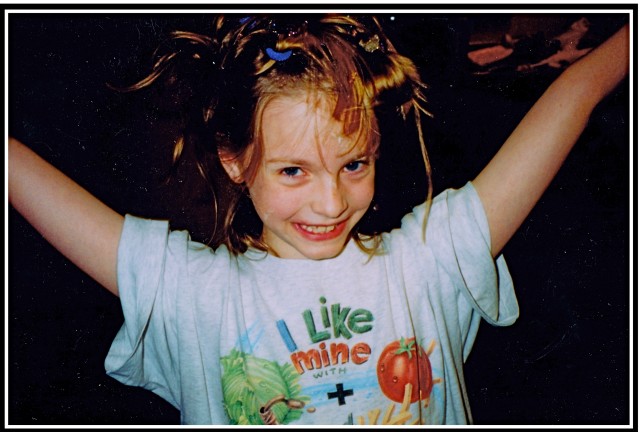 But looking back, there were a few minor abnormalities.
But looking back, there were a few minor abnormalities.
I was a colicky baby, allergic to milk until age five. I was prone to catching pneumonia. Always a dancer, I was remarkably flexible even among the other little ballerinas… I was the only sugarplum fairy who could jumprope with her arms.
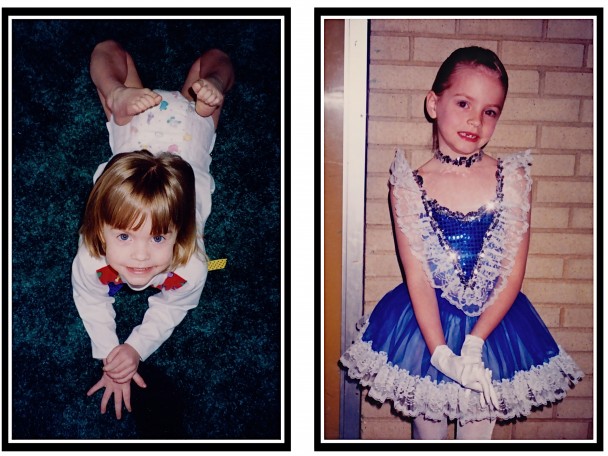 My body didn’t heal properly; I had my ears pierced three or four times, and each time the earrings were removed, the holes closed up instantly, imminently leaving this glamour girl with very un-chic earlobes. And as early as age ten, I was receiving snickers in PE class due to my purple splotchy legs, a phenomenon I later discovered to be called Raynaud’s Syndrome.
My body didn’t heal properly; I had my ears pierced three or four times, and each time the earrings were removed, the holes closed up instantly, imminently leaving this glamour girl with very un-chic earlobes. And as early as age ten, I was receiving snickers in PE class due to my purple splotchy legs, a phenomenon I later discovered to be called Raynaud’s Syndrome.
I was a silly little girl, and we only considered these quirks an addition to my own unique charm.
But when I was twelve years old, everything began to change.
2003-2004
We can pretty much pinpoint the triggers of my health decline to two specific incidents in 2003.
The first of these events took place that summer; I returned home from camp with a large circular bite on my leg. I was only planning to be home for the weekend, leaving for yet another week away at a different camp the next day. So we made a trip to the emergency room to get this checked out. The doctor diagnosed it as a spider bite, and sent me home with steroids and antibiotics. It was certainly very memorable, about six to eight inches in diameter; but aside from that, I didn’t seem to experience any negative effects at the time… Other than the doctor putting the kiboshes on my intended departure for camp the following morning. (I bet you never knew I was such an venturesome wilderness girl! Granted, my camp activity of choice might have been recreational flirting… But still, I delighted in the adventure that was lurking around every corner!)
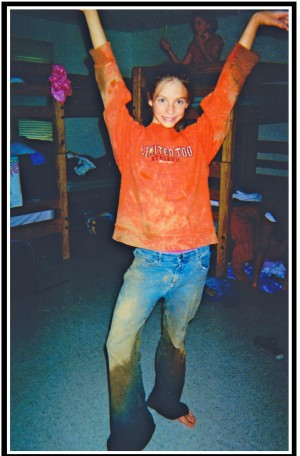 The second incident occurred just two months later when I came home from a horseback riding camp in a more concerning predicament. The day following my return home I began feeling horribly exhausted, with an intensely sore throat and swollen, painful lymph nodes. Of additional concern, I learned that the horse I road and cared for at camp had mysteriously died the night I became so sick. We still don’t know what significance this holds, but suffice it to say that these circumstances were a bit disturbing. Interestingly enough, more than one doctor has quipped, “At least you were stronger than the horse.” I guess that qualifies as a “silver lining,” huh?
The second incident occurred just two months later when I came home from a horseback riding camp in a more concerning predicament. The day following my return home I began feeling horribly exhausted, with an intensely sore throat and swollen, painful lymph nodes. Of additional concern, I learned that the horse I road and cared for at camp had mysteriously died the night I became so sick. We still don’t know what significance this holds, but suffice it to say that these circumstances were a bit disturbing. Interestingly enough, more than one doctor has quipped, “At least you were stronger than the horse.” I guess that qualifies as a “silver lining,” huh?
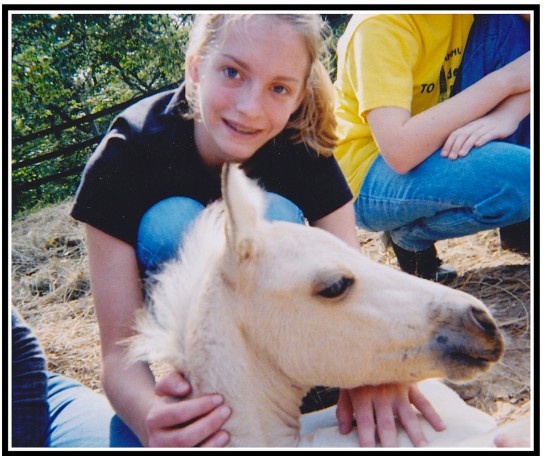
After a visit to the doctor, cultures showed that I had a staph infection in my throat. This infection kept me in bed for about a month, but even when later cultures were clear of infection I suffered from very severe throat pain for many months, and my lymph nodes continue to be swollen and achy even today. In the winter of that year, I found myself in the emergency room a couple of times with fevers, unable to stop vomiting, dehydrated, and with inexplicably high inflammation markers. Still, I was bent on participating in school, dance, swim team, and cheerleading as best I possibly could.
2005
But in the early days of 2005, a pirouette gone amiss sent me twirling down Alice’s proverbial rabbit hole… Except I didn’t land in Wonderland, and I never awakened only to find that my curious adventures were merely a dream. On January 6, I sprained my ankle in pointe class. Over the next few days, I was disconcerted to find that my foot was drastically changing colors and temperatures, and the pain had intensified to such a degree that even the lightest touch of a cotton ball could bring me to tears.
I was diagnosed with Reflex Sympathetic Dystrophy (RSD), also called Complex Regional Pain Syndrome (CRPS), a neurological pain condition. This causes my body to continually misfire pain signals, amplifying pain even after the initial trauma has passed. Thankfully my ankle pain resolved following aggressive treatment with loads of medications, weeklong epidurals, and nerve blocks.
Soon after, I completely lost my appetite and developed unbearable stomach pain. I could only manage to eat small bites of cereal and baby food, leaving me malnourished as my weight quickly dwindled. Traditional diagnostic testing did not reveal any obvious cause behind this pain, so my doctors made the reasonable assumption that my RSD had spread to my stomach.
I resumed treatment of medications, epidurals, and nerve blocks, but the pain did not subside. Because of the debilitating side effects from the medicines and my extreme pain, participation in school and my beloved extracurricular activities was no longer a possibility.
2006-2007
After a year and a half of constant stomach pain, I finally found some relief through hyperbaric oxygen treatments! I was still in pain and eating was very difficult, but I was overjoyed at achieving any improvement. My mom and I made many long-term trips to the Chicago suburbs for my treatments, but when I wasn’t traveling, I was thankful to be able to participate, at least in part, in some typical high school experiences. I even was able to ride horses again!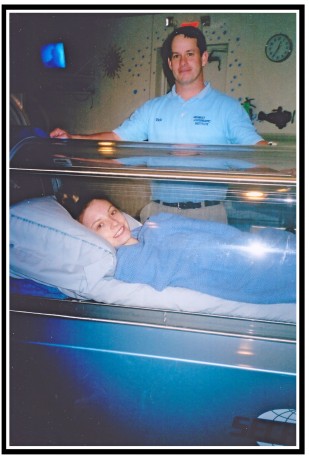
2008-2009
By Fall 2008, I was no longer responding to hyperbarics. Gradually my pain advanced through my entire body.
The following spring I developed a very severe headache with extreme light sensitivity, which continues to be unrelenting to this day. Indoors I can only tolerate 15-watt lightbulbs. But I am incredibly grateful for my hand-painted prosthetic contact lenses. Because of these lenses I am able to be out in natural lighting without my standard dorky blue sunglasses and baseball cap! Being a fashion-minded 22-year-old girl, I greatly appreciate this blessing.
But due to these new symptoms and exacerbated pain, I was forced to put my plans of going to college on hold. With a growing suspicion that I might be suffering from some other ailment in addition to RSD, my family and I began actively searching for more answers, a quest that has taken us to doctors all over the country.
We investigated the possibility of my having contracted some form of infection as a result of the bite I received at camp. We also questioned if I could be experiencing lingering effects from exposure to something harmful at horseback riding camp. Two or three times I was prescribed short rounds of intramuscular and intravenous antibiotics, but my symptoms did not improve.
Also in 2009, following a ketamine infusion aimed at relieving my RSD pain, I experienced my first episode of paralysis, a horribly unnerving occurrence. From that time forward I continued having paralysis after the majority of my procedures requiring anesthesia.
2010
In March of 2010, I traveled to Philadelphia for a series of gastric motility tests, leading to a diagnosis of Gastroparesis, or paralysis of the stomach.
At this point my body was no longer tolerating solid food. And even a completely liquid diet was horribly challenging. Because of my agonizing abdominal pain and difficulty swallowing, I had to take tiny sips of meal supplements around the clock in order to take in anywhere near an adequate amount of calories, a positively exhausting feat which had become nearly impossible. With my doctor’s guidance I made the tough decision to have surgery to place a J- tube, a feeding tube that feeds directly into the jejunum, bypassing the stomach.
But before this surgery was to take place, I had three procedures done at once; I had a port placed so that I could begin intravenous immunoglobulin (IVIG) therapy, a liver biopsy, and a lumbar puncture. Following this all-too-ambitious venture, I had the most severe and traumatic reaction I have ever experienced, leaving me paralyzed and in excruciating pain for a week, and unable to take more than a few steps for the next month. My right arm has been fixed in a hyperextended position ever since, causing me to have constant and intense pain in my elbow.
Soon it became evident that my digestive tract paralysis extends beyond my stomach into my intestines. Because of this finding and the repercussions of my recent procedures, my doctors and I realized that proceeding with the feeding tube placement as planned would be a foolish and useless intervention.
Since then I have been receiving Total Parenteral Nutrition (TPN). Every night I am connected to a giant heavy bag with 3250 mL of fluids containing all of my nutrition, which is delivered into my veins through a central line in my chest.
2011
For quite some time I have had consistent pancytopenia, or low blood counts, but up to this time we had no explanation as to the cause of this. But in February of 2011 I found myself in the hospital with a persistently raging fever, depleted blood counts, and dramatically elevated liver enzyme levels and inflammation markers. I suffered through two weeks of this before a hematologist was finally consulted. I was given a blood transfusion, which settled my symptoms. A bilateral bone marrow biopsy was performed, but both samples were botched, coming up with cartilage instead of marrow.
But when I had a nearly identical episode a few months later, a successful bone marrow biopsy revealed that I have Hemophagocytic Lymphohistiocytosis (HLH), a very rare cancer-like disease typically found in babies and young children. Initially I received treatment consisting of daily injections of a rheumatoid arthritis medication. My body was too weak for the customary HLH protocol of chemotherapy, steroids, and a potential bone marrow transplant. I am very fortunate to have had this option… Many children are not so lucky and have no choice but to proceed with this harsh treatment plan for even a chance of survival. Currently we are doing our best to keep me stable by giving me blood transfusions as needed and by being extra careful to prevent any infections which can easily send me into a flare. This way my body will be as strong as possible should my HLH someday demand more aggressive treatment.
A few weeks later I was clinically diagnosed with mitochondrial disease, often referred to as simply “mito”. Mitochondria are responsible for producing most cellular energy, and when they do not function properly, mito develops. My mito geneticist believes that mitochondrial disease could explain my wide variety of diagnoses.
2012-2013
Now back to the original inquiry: “What exactly is it that is wrong with you?”
Although we are learning more and more, there are still too many unanswered questions. But right now the predominant hypothesis as to why and how I possibly acquired this, um, impressive collection of rare diseases is this:
Most likely I have had some genetic abnormalities my entire life. As a child my mild stomach troubles, hypermobility, and abnormal healing may have been early evidence of this. When I was 12 years old, perhaps the stressors of the bite and staph infection triggered an over-exaggerated immune response and things got crazy, setting off my mito, HLH, RSD, digestive tract paralysis, and all of the symptoms that go along with them. But we continue searching for answers to either conclusively substantiate or negate this hypothesis.
Confusion sets in when we consider that there are genetic and acquired forms of both HLH and mito. All of my doctors agree that the underlying cause of my illness likely falls into the genetic realm, but we aren’t so sure which condition I have because of a mutation… Is it familial HLH? Primary mito? Both? Or another genetic factor? Research into the complexities of human genetics is quickly progressing, but in many instances it will still take years of processing and analyzing newly available data to gain understanding of the manifestations of various mutations.
And we would be thrilled if we could dismiss the possibility of an underlying infection, but unfortunately there seems to be no foolproof diagnostic test for this, either.
Are you beginning to envision this befuddling predicament? My mind reels just thinking about it.
Currently I have results pending for whole exome sequencing, a test that is investigating my entire exome, along with those of my parents. Our hope is that the results of this highly informative genetic testing may reveal why I have HLH, whether or not I have mito, and the reason behind my paralysis following procedures. These are lofty expectations to be sure, but any one of these answers could be very helpful in developing an ideal treatment plan for me. I have brilliant and caring doctors in St. Louis, Cincinnati, Baltimore, Los Angeles, and Kansas City working on my behalf, all of whom are very dedicated and trustworthy.
At the beginning of my illness, if someone had told my 12-year-old self that I would still be sick a full decade later, I’m sure I would have been terrified. But the Lord has held my hand along every winding bend of this journey. Of course I hope with my whole heart that someday I will be healthy, but no matter what, I trust that God’s will is truly what is best. It is really quite amazing to see how He continually creates opportunities that bring the most marvelous and unexpected blessings through my one-of-a-kind experiences.
He has provided me with a most loving and supportive family. I am so thankful for my awesome friends, many of whom I never would have met if not for my medical journey. And that sweet little Double Doodle Alice Eloise? With her as my loyal and constant companion, how can I not be full of smiles?!
God has blessed me with a beautifully unique life… And I love it!
“Be joyful always; pray continually; give thanks in all circumstances, for this is God’s will for you in Christ Jesus.”
1 Thessalonians 5:16-18


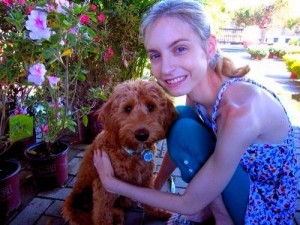




24 Responses to Down the Rabbit Hole: A (Somewhat) Comprehensive Account of my Curiouser and Curiouser Adventures